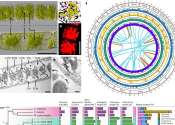A 'cosmic glitch' in gravity: New model may explain strange behavior on a cosmic scale
A group of researchers at the University of Waterloo and the University of British Columbia have discovered a potential "cosmic glitch" in the universe's gravity, explaining its strange behavior on a cosmic scale.









